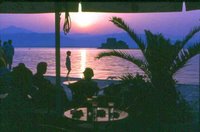

(A version of this story appeared in March 2005.)
Nafplio, Greece may be the Peloponnesean peninsula's most beautiful town, and life there moves at the unhurried, languid pace of hot places. When in Nafplio, visitors who live by the "early to bed, early to rise" maxim at home find themselves making adjustments to their usual routines.
Old, cobbled, twisting and whitewashed, Nafplio rises late, bustles from mid-morning to mid-afternoon, closes up tight for rest and family meals during the afternoon’s hottest hours, goes back to work for a bit in the early evening, dines at ten and later, then cruises the seafront promenade until the cool, early hours of tomorrow morning.
Nafplio's action centers around Syndagma (Constitution) Square and the quay built along the Aegean.
Syndagma is a sweeping, marble-cobbled public space ringed by tavernas and anchored by fabulous architecture that tells Nafplio’s history. Sit at an al fresco café table and absorb a view that serves up the Palamidi, the 700-foot-high Venetian fortress and crown of Nafplio; an imposing 18th-century Venetian naval warehouse-turned museum; an exquisite brick mosque built by the Ottoman Turks and reincarnated by the Greeks as a movie theater; and the square itself, site of fervent demonstrations for Greek independence and a Greek constitution.
Nafplio also hangs out on its seafront promenade (small photo), and evening is when things come alive. The place to be is quayside Bouboulina Street, named for Laskarina Bouboulina, a widowed mother of seven who commanded significant naval operations during the 1821 Greek War of Independence against the Ottoman Turks and who participated personally in the siege of Nafplio.
Along Bouboulina Street couples stroll; grandmothers sit with grandbabies on their laps; small boys hold their fathers’ hands and lean down over the water looking for fish; young people cruise the promenade on motorbikes; taverna diners turn their chairs toward the sea and linger over meals of sparkling seafood served by places like the Poseidon (large photo); whole families walk the cobbles, sometimes holding hands; tourists try to capture the mellow mystery of this beautiful place, easing themselves into café seats, envying the people who live here; trios and quartets of big-bellied old men in short-sleeve shirts sit on waterfront benches, stare out at the rippling water, and retell worn, treasured stories.
Out in the bay, where boats bob at anchor, floats the Bourtzi (peeking between the palm fronds in the bottom photo), turned silhouette by a fireball sunset that paints the sea and sky orange and magenta and the Argolid mountains purple.
The Bourtzi looks like a dream, but the vision belies the building’s turbulent past. Built by the Venetians in 1471, it and its namesake island began life as a fort – Castel Pasqualigo – built to protect the entrance to what was then Venetian Napoli. After Venetians, Byzantines and Turks left the scene and Greeks regained control of Nafplio in 1822, the Bourtzi did a stint as a prison.
It later became home of the town’s hangman. Town elders had to ensure that Nafplio’s citizenry wasn’t sullied by contact with the man with the dirty job. So, to keep him a proper, decorous distance from townspeople, municipal leaders sequestered the hangman out in the harbor in the cold stone rooms of the old prison, where he effectively became a prisoner himself.
Today, people sit in Nafplio and look wistfully out at the Bourtzi. A hundred and fifty years ago, a man with a job considered necessary but too foul to allow intercourse with the general populace sat in the clammy, sunless rooms of the Bourtzi and looked wistfully in at Nafplio.
www.LoriHein.com
